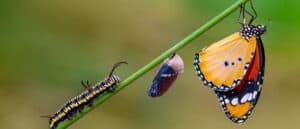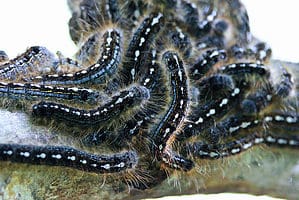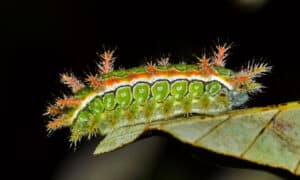Caterpillars come in all different sizes and colors. However, a surprisingly large number of caterpillars are black and yellow. Identifying these caterpillars requires noticing the caterpillar’s pattern, size, and shape. Luckily, caterpillars tend to vary enough that identifying them isn’t difficult – even if so many have the same colors.
Caterpillars rarely resemble the moths or butterflies they turn into. Just because a caterpillar is yellow and black doesn’t mean that it will turn into a yellow and black butterfly. Therefore, caterpillars must be identified without necessarily considering what they’ll be as adults.
Below, we’ll discuss the different types of yellow and black caterpillars common in North America. We’ve included pictures as well as identification tips.
1. Monarch Caterpillar
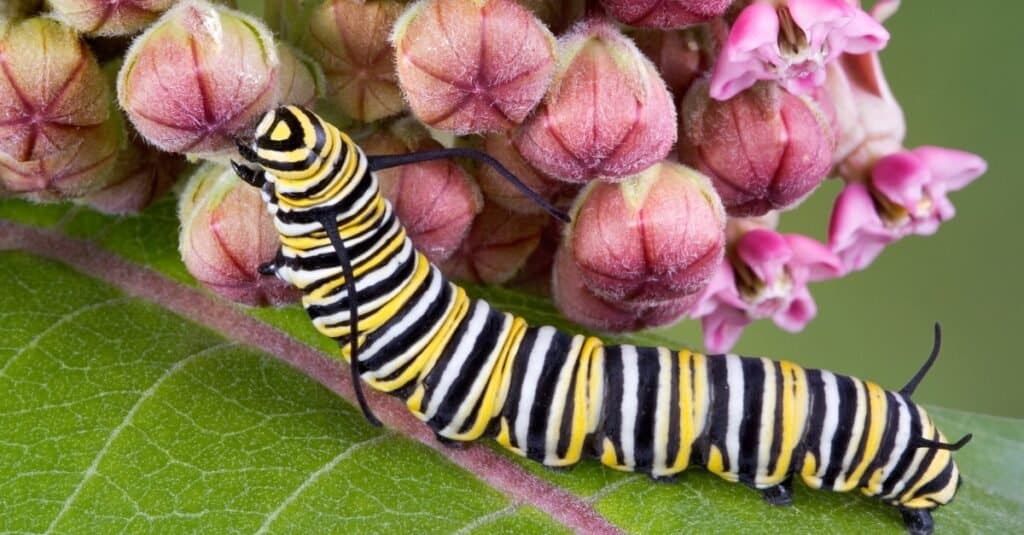
The monarch caterpillar is a familiar black and yellow caterpillar, but their numbers dwindled over the last decades.
©iStock.com/CathyKeifer
The monarch caterpillar features stripes of yellow, white, and black. They’re long and wide and often described as “fat.” They can reach up to 1.7″ long – making them extremely long for a caterpillar. They have black tentacles on either end of their body, which they use to find their way around.
The monarch caterpillar eats exclusively milkweed. Therefore, their diet makes them one of the few poisonous caterpillars. However, their dependence on the milkweed plant has made their population fall over the last few decades.
2. White-Marked Tussock Furry Horned Caterpillar
This caterpillar has a strange appearance that makes it pretty easy to identify. They have a red tuft on their head and tufts of yellow fur along their back. Two long, black tentacles poke out from their head, and a long one shoots upwards from their hind end. They can measure up to 1.3″ and are often easy to identify.
Their hairs cause allergic reactions in people. Therefore, they can “sting” when touched. Their stings aren’t toxic, though.
3. Yellow Spotted Tussock Moth Caterpillar
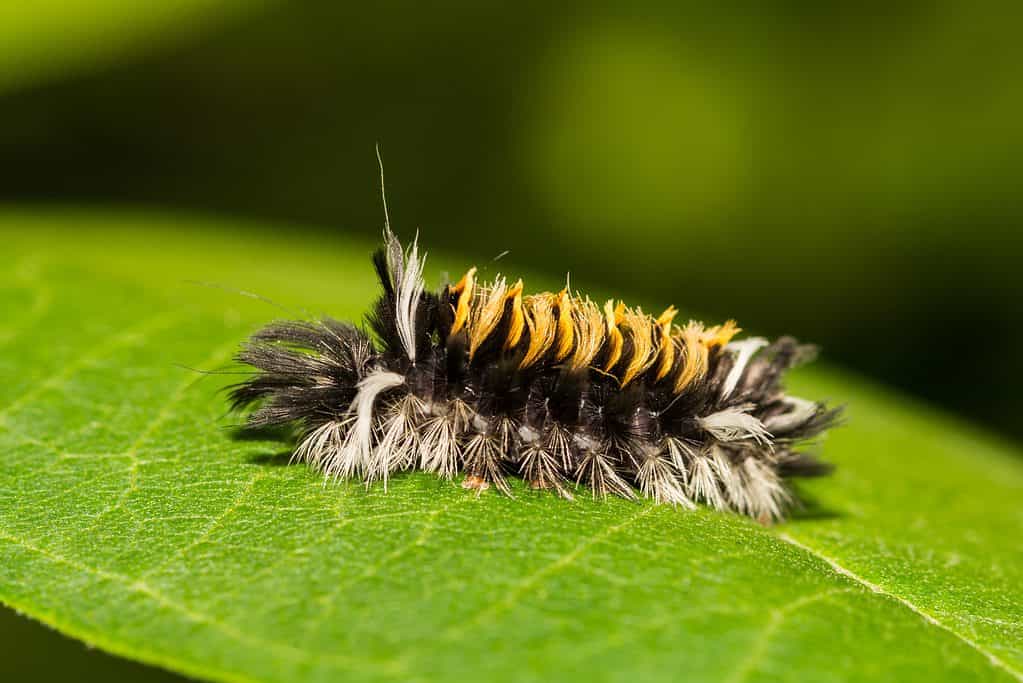
This insect may look like a bumblebee, but it’s actually a black and yellow caterpillar.
©Jay Ondreicka/Shutterstock.com
This brightly colored caterpillar is often described as looking like a bumblebee. They’re black on either end with a wide yellow band across their midsection. They also have thin white hairs that shoot out from either end.
These caterpillars aren’t toxic. However, they can sting you with their furs. These tiny furs cause allergic reactions in humans, which is why they are described as “stinging.” They often feed on willow, maple, oak, and alder.
4. Six-Spot Burnet Caterpillar
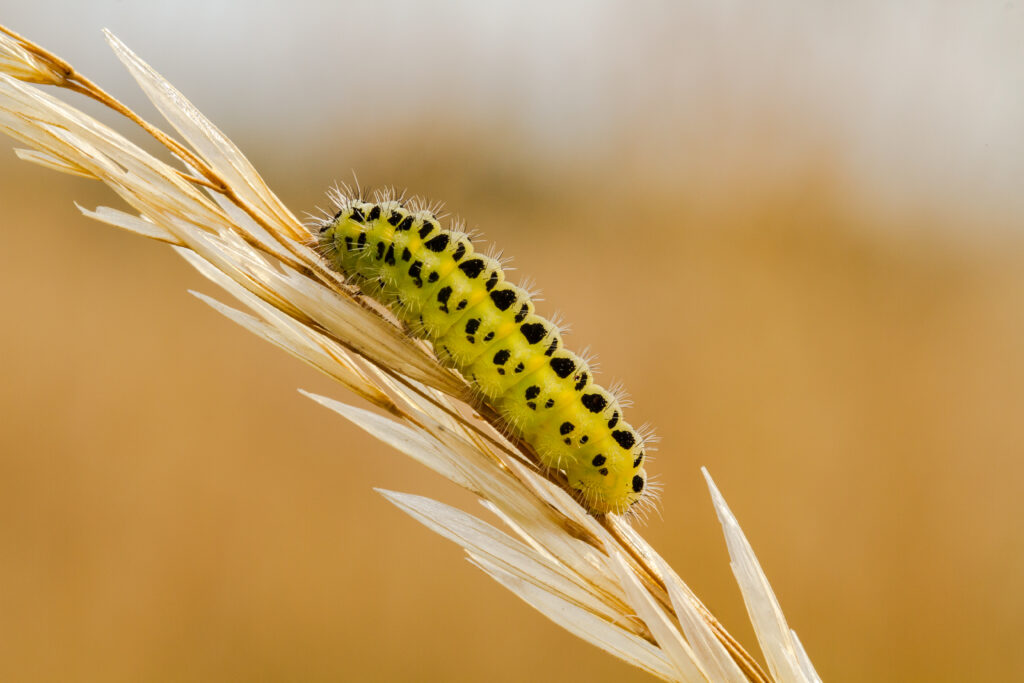
Six-spot burnet caterpillars are yellow and black.
©ColleenSlater Photography/Shutterstock.com
Despite the name, this caterpillar has a lot more than six spots. They’re fat and yellow with black spots in a line across its body. You’ll also notice tiny pieces of hair across much of its body, though it isn’t exactly “furry.”
They’re a rare caterpillar that turns into a daytime moth (one of the very few in the world). The moth has six spots, which is where the name comes from, but it can confuse identifying the caterpillar.
5. Queen Caterpillar

A queen caterpillar may be black or yellow, but its stripes can also be green, brown, or blue.
©iStock.com/DrWD40
The Queen Caterpillar looks similar to the monarch. It has white and black stripes. However, in between sets of these stripes, it has yellow dots. Black tentacles sprout on either side of the caterpillar’s body (which also makes it look a bit like a monarch). The white stripes can sometimes turn green, brown, blue, or yellow.
This caterpillar turns into a bright, red butterfly – nothing like its caterpillar form.
6. Catalpa Sphinx
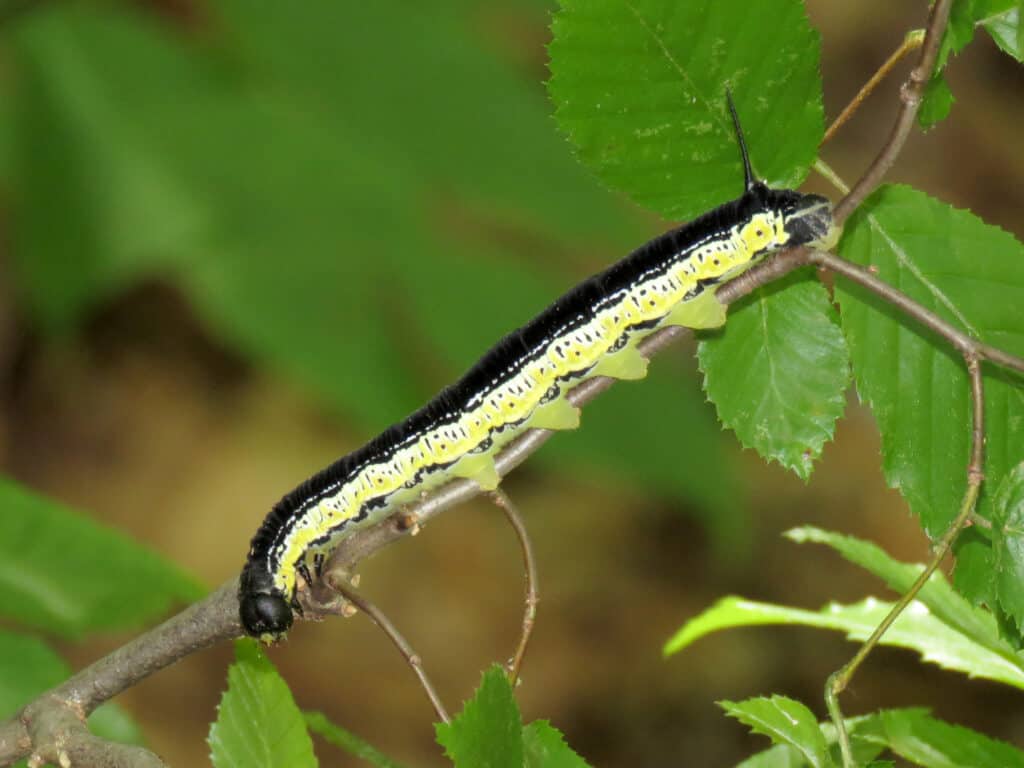
The Catalpa sphinx is one of the larger caterpillars and can grow up to 2 inches long.
©Katja Schulz from Washington, D. C., USA, CC BY 2.0 <https://creativecommons.org/licenses/by/2.0>, via Wikimedia Commons – License
This caterpillar is jet black with yellow stripes running down both sides of its body. These stripes are typically wide and broken up by dots of black. Younger caterpillars are often lighter in color and may have no markings. As the caterpillar ages, it darkens and gets yellow markings.
The Catalpa caterpillar can grow up to 2″, making it one of the larger caterpillars. They feed on catalpa trees, where the species gets its name. After maturity, the caterpillar turns into a giant brown moth.
7. Giant Sphinx Caterpillar
The Giant Sphinx caterpillar can grow up to 6″ long, making it one of the larger caterpillars. It is jet black with yellow stripes across its body. The head is red and very distinguished from the body. Furthermore, it has an orange-ish tail that makes it easy to identify.
This caterpillar is poisonous to small animals and birds. Plus, it has stinging hairs and can bite when cornered. It is not a caterpillar you want to mess with.
8. Black and Yellow Zebra Caterpillar
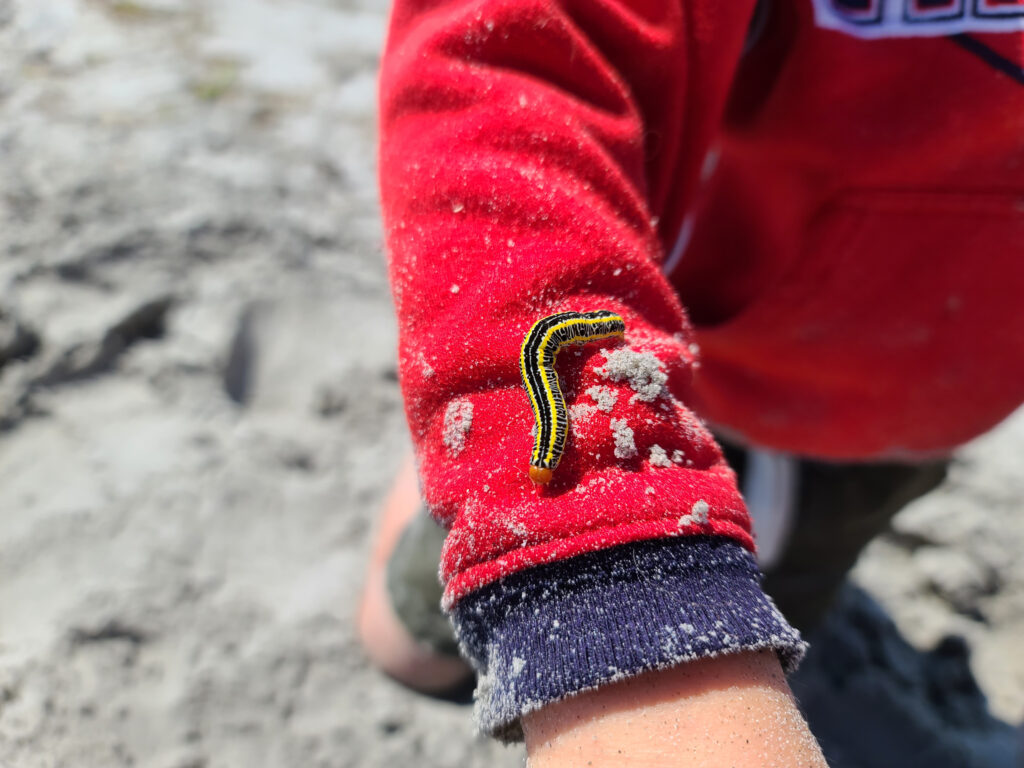
Black and yellow zebra caterpillars feed on various crops, vegetables, and trees.
©Patrick Hatt/Shutterstock.com
This caterpillar looks very similar to the others we’ve already mentioned. It has black and white stripes across its body with an orange head and hind end. It has a bit of a zebra-like pattern. However, the stripes are very small. They can measure up to 1.6″ long at maturity.
9. Common Sheep Moth Caterpillar
This caterpillar is strange, making it easy to identify. It is mostly brownish-black but has yellow/red tufts on the top. These furry tufts can sting, which is one reason they’re brightly colored. The brown, jagged appearance also makes the caterpillar blend in easier with its surroundings.
They feed on bitterbrush, wild rose, and mountain lilac. Once mature, the caterpillar turns into a bright orange moth.
10. Yellow and Black Cinnabar Caterpillar
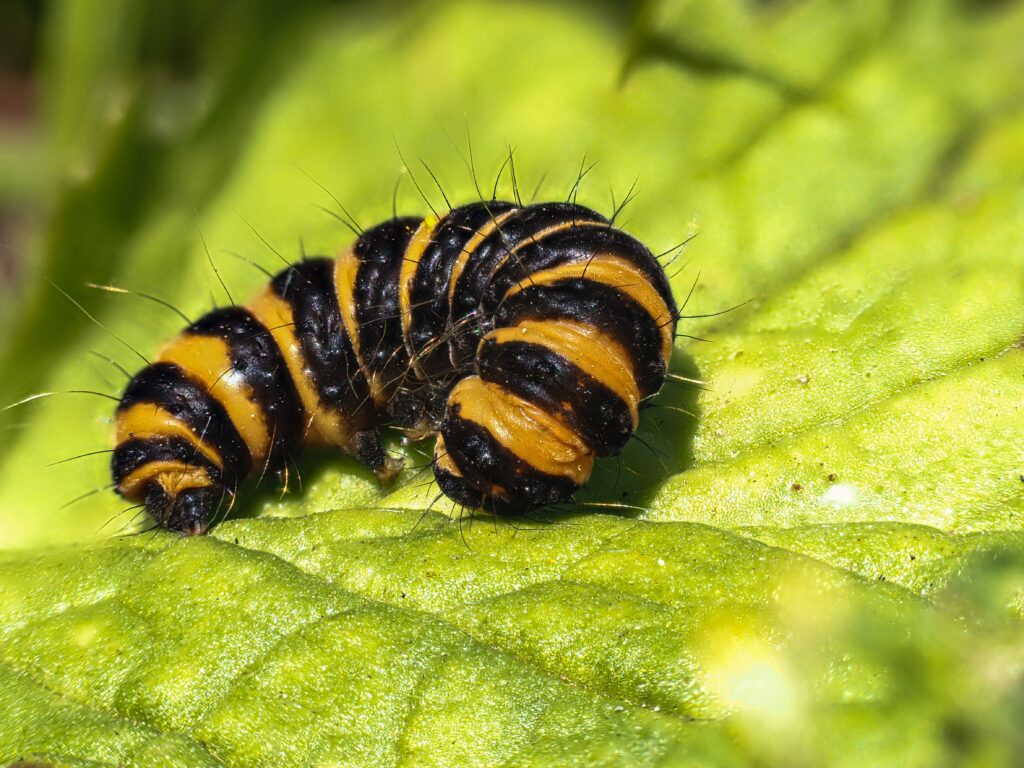
The Black and Yellow Cinnabar Caterpillar is found in Britain and certain areas of Europe.
©Signe Hoppe Fotografie/Shutterstock.com
This glossy caterpillar has brightly colored yellow and black stripes. It is poisonous, so the stripes warn potential predators not to eat the caterpillar. This caterpillar has no fur on its body, making it look glossy. However, it does have a few thin hairs that can potentially sting if you touch them.
Usually, this caterpillar feeds on ragwort leaves. Therefore, you can use the plant to help identify the caterpillar.
11. Brown-Hooded Owlet
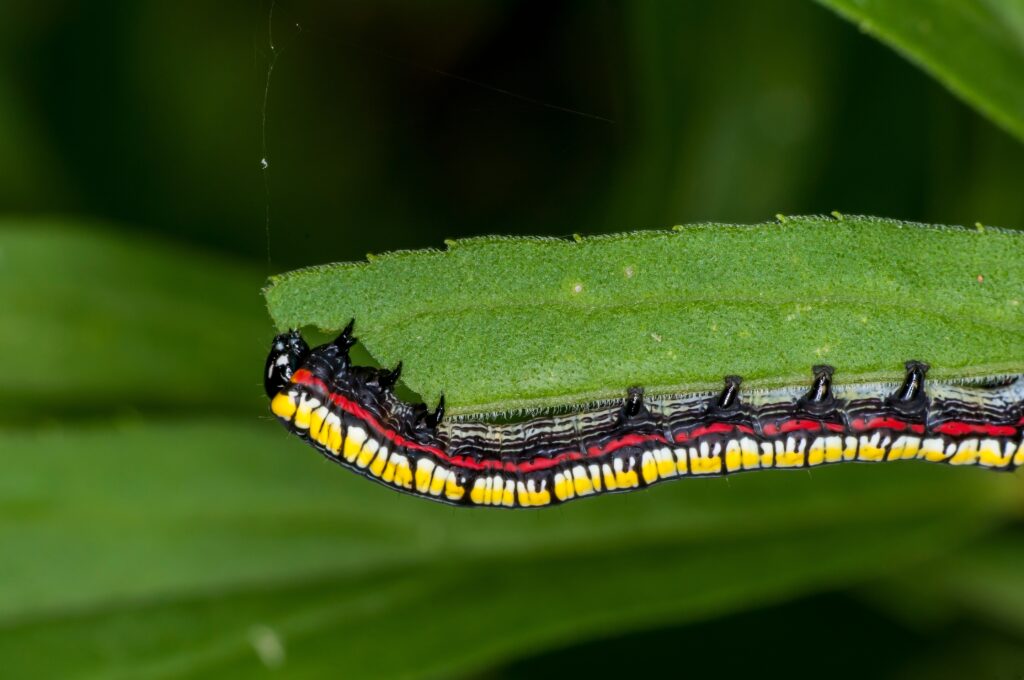
Brown-hooded owlet caterpillars are also known as Calico caterpillars due to their pattern.
©Michael Siluk/Shutterstock.com
This caterpillar is quite colorful. It has yellow stripes across both sides of its body and horizontal red lines near its bottom. It is shiny black across the top, with some black markings within the yellow stripes.
This caterpillar has a “calico” pattern due to all its colorful stripes.
12. Black Swallowtail Caterpillar

Black Swallowtail Caterpillars can vary with their black and yellow stripes.
©Graphicato/Shutterstock.com
This caterpillar is mostly green. However, it has yellow and black stripes across each section of its body. The younger caterpillars may not have the yellow or black markings, though. Instead, they often have a white band across the middle. This caterpillar changes its appearance as it matures.
13. Yellownecked Caterpillar

Yellownecked caterpillars have white hairs on their body and black and yellow markings.
©RHMeeks/Shutterstock.com
The yellownecked caterpillar is mostly black with thin white stripes running down its body. It has a yellow neck, where it got its name. It also has long white hairs across its’ body. Its head is completely black. Due to the long stripes, this caterpillar is pretty easy to identify.
14. Mullein Moth Caterpillar
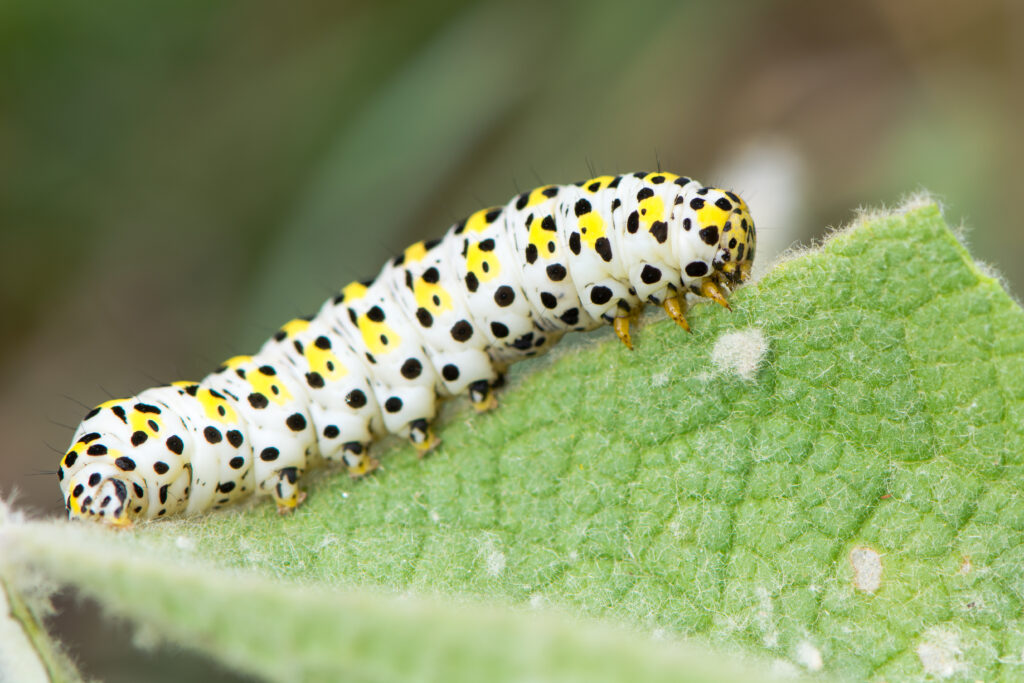
The Mullein Caterpillar moth is found in the British Isles.
©IanRedding/Shutterstock.com
This unusual caterpillar is translucent white with black and yellow spots across its body. It can be pale green instead of white, as well. Caterpillars may change appearances as they age. They’re only about 2″ long and feed on the Buddleia leaves.
They usually come out in July and August, when they can defoliate whole bushes. They’re considered pests in many areas for this reason.
15. Grapeleaf Skeletonizer Caterpillar
The Grapeleaf Skeletonizer is completely yellow with small black dots along each section of its body. These caterpillars munch on grapevine leaves, which is how they got their name. They’re considered pests and a serious issue for vineyard owners.
When they feed, these caterpillars line up in a row. They aren’t poisonous. However, they are covered in irritating hairs that can give humans a rash. These hairs can cause allergic reactions in some situations.
16. Redhumped Caterpillar

Redhumped caterpillars feed on fruit trees including apple, pear, and plum.
©Gerry Bishop/Shutterstock.com
These caterpillars have bright, yellow bodies with black and white bands running down them. They have very distinguished red humps on their back that resemble sores. However, they’re normal and not a sign of anything wrong with the caterpillar.
These caterpillars feed on cottonwood, willow, fruit, and walnut trees. They aren’t very picky about what they eat, unlike other caterpillars.
17. American Dagger Caterpillar
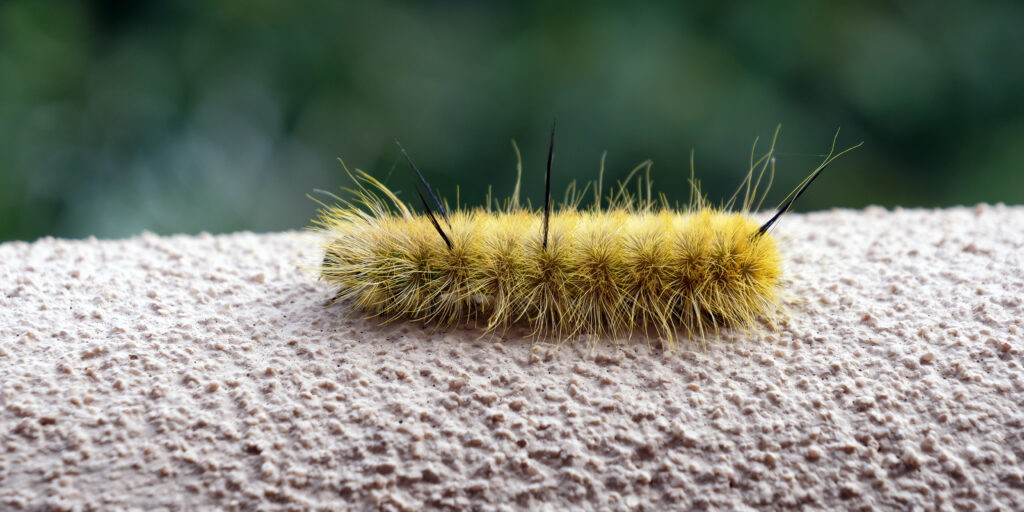
American Dagger Caterpillars are toxic and cause stinging when they’re touched.
©Martha Marks/Shutterstock.com
These caterpillars are completely white and fuzzy. They have fine, white hairs along their whole body, making them look like shaggy dogs. They also have a few black spines. Their glossy head sets them apart from other white caterpillars, making them easier to identify. They’re commonly found on birch, maple, oak, and poplar trees.
Their white fur can have a yellowish tint, so we decided to include them on this list even though they aren’t truly yellow.
18. Smeared Dagger Most Caterpillar
This caterpillar has a mostly black body with white markings. It is covered with tufts of spines that are venomous. Therefore, it is best to avoid them altogether. They also have a wavy yellow line along the bottom of their body. Overall, they’re very easily distinguishable.
These caterpillars aren’t picky about what they eat. Therefore, you can find them on many fruit trees and shrubs. They’re also a fan of willows and oaks.
19. Fall Webworm
The Webworm comes in many different colors. They’re often pale yellow with black dots. However, they can also be light grey or even green. Sometimes, their markings are a lighter color rather than black. Each segment of the insect will have white or yellowish bristles. These can sting and should be avoided.
These caterpillars love crabapple, cherry, walnut, and similar trees. However, they aren’t as picky as other caterpillars, so you can find them on various plants.
20. Red Admiral Butterfly Caterpillar
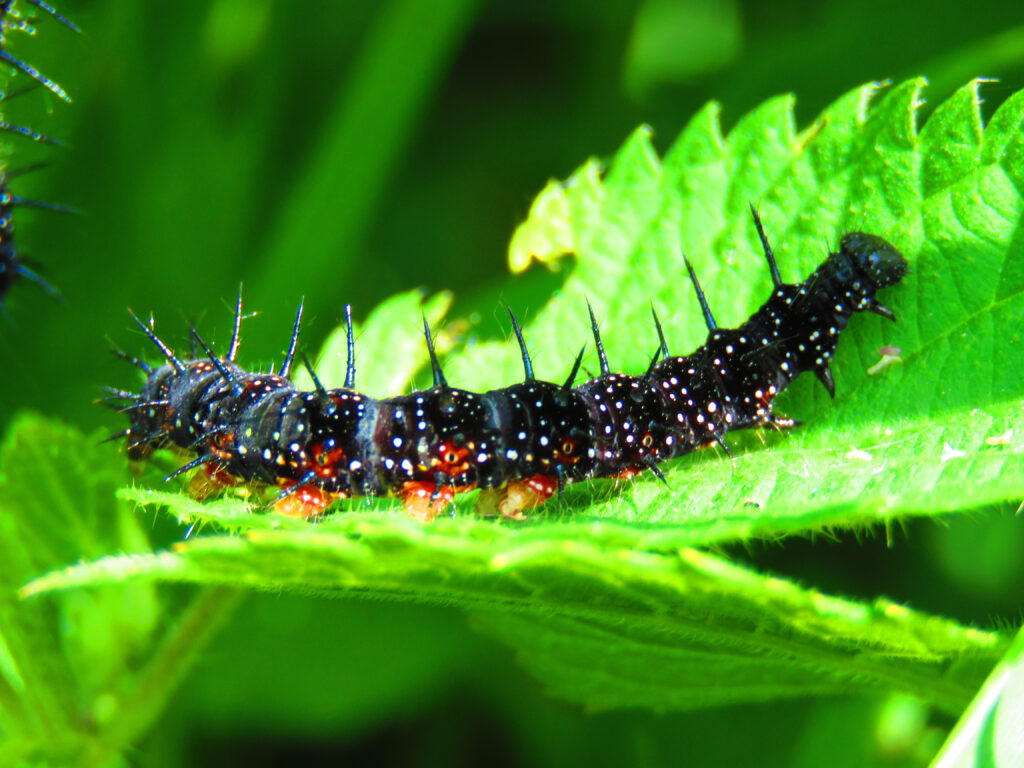
Though it’s in their name, Red Admiral Caterpillars aren’t red.
©Przemyslaw Muszynski/Shutterstock.com
As their name suggests, these caterpillars turn into red admiral butterflies. However, as caterpillars, they aren’t red at all. Instead, they’re mostly black with yellow patches on their sides. They’re covered in short, white furs that can sting if you touch them.
These caterpillars create a tent and live in it almost exclusively. They only emerge when they need to eat. They typically consume the stinging nettle plant.
Like many caterpillars, this one changes as it matures. When they are younger, they may be lighter in color.
21. Erasmia pulchella
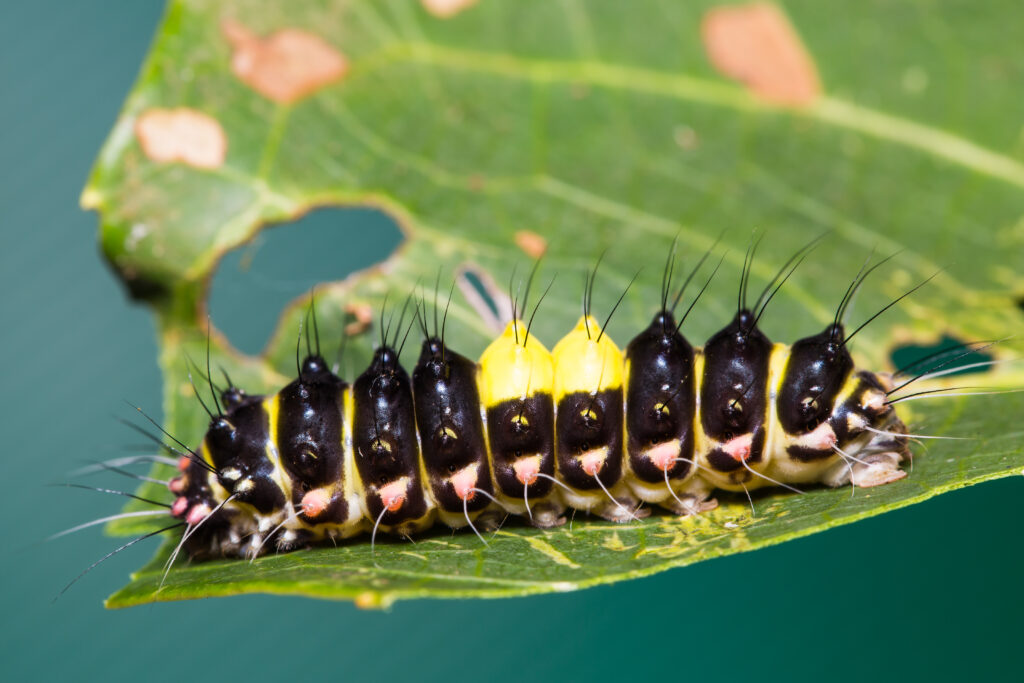
Erasmia caterpillars are native to East Asia.
©Matee Nuserm/Shutterstock.com
The Erasmia pulchella is strange-looking and doesn’t look much like a caterpillar at all. They’re mostly black but with some segments of yellow on their top. Along their sides, they have red dots, and from these red dots, small white hairs grow. These features make the caterpillar pretty easy to identify.
The caterpillar is extremely bumpy. Though you can’t see them distinctly without a magnifying glass, they have fleshy tubes on each segment.
This caterpillar is poisonous to any animal that consumes it, which is probably why it is so brightly colored.
22. Neighbor Moth Caterpillar
This moth caterpillar is mostly black. However, they have a yellow band along each side and smaller white stripes along their back. They also have black hair and spines covering much of their body. Overall, the caterpillar is pretty small and slender. It can only grow to around 13 mm long, much smaller than most caterpillars.
These neighbor moth caterpillars can be found throughout much of the United States. They consume practically all native deciduous trees, including hazelnut and oak. They aren’t very picky, so you can find them on practically any tree with edible leaves.
23. Virginia Ctenucha
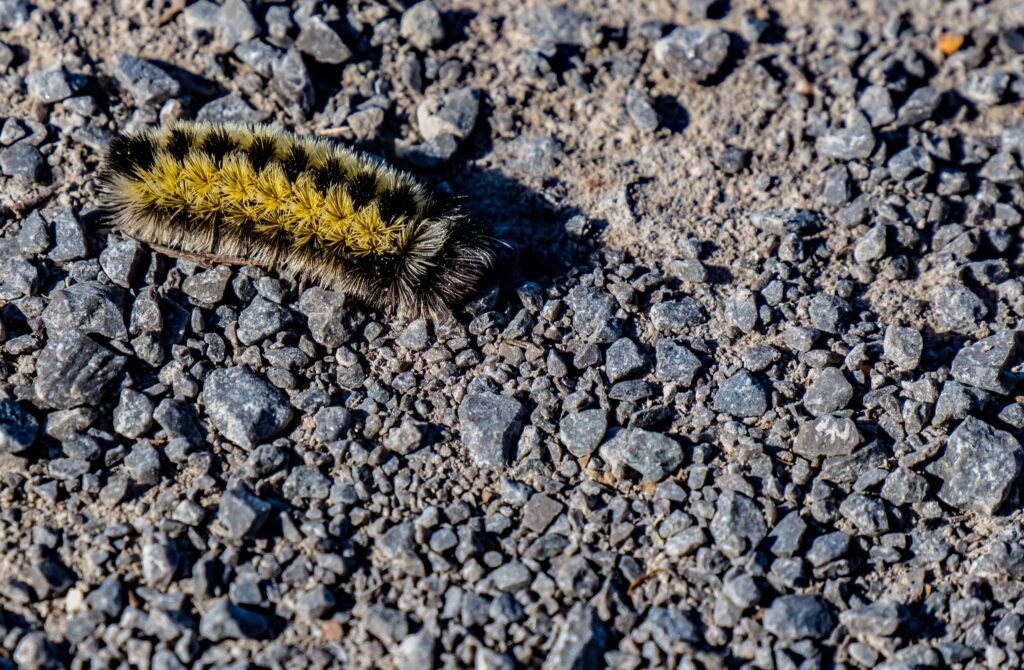
Virginia Ctenucha was first recorded in 1794.
©Jennifer H. Seeman/Shutterstock.com
This moth larva looks like a giant fuzzball. They’re covered with tufts of yellow and black hair. They also have red heads and red prolegs. They can grow up to an inch, making them sizable. They’re found throughout the United States, where they consume many kinds of grass.
Despite their somewhat intimidating appearance, these caterpillars are completely non-toxic.
24. Toadflax Moth Caterpillar
This caterpillar starts as almost completely black. However, as the insect matures, it develops yellow stripes and white dots. By the time it is fully grown, it looks completely different than it did as a younger caterpillar. This species starts out very small at only five mm, but it quickly grows to an inch and a half long.
When larger, these caterpillars can quickly defoliate toadflax plants, their primary food source.
Despite changing appearance halfway through maturity, these caterpillars are easy to identify due to their distinctive markings.
25. Buff-Tip Moth Caterpillar

Buff-tip moth caterpillars can camouflage themselves as twigs.
©Sandra Stanbridge/Shutterstock.com
This caterpillar looks like many of those we’ve talked about thus far. They’re mostly black. However, they have orange-yellow stripes that crisscross their body. They also have white hairs along much of their body, which can irritate your skin. It is best not to touch them with bare hands, as this can cause irritation. They aren’t toxic and don’t cause allergic reactions (usually), though.
The Buff-Tiped Moth Caterpillar can grow very long at up to 3 inches. However, they’re extremely slender.
26. Grass Eggar Moth Caterpillar
This moth caterpillar is mostly black. However, it is covered with yellow-orange hair. Therefore, from a distance, it looks completely orange. It isn’t until you get up close that you’ll notice it’s just hairy.
These caterpillars can be pretty large. They can grow up to 2.5″ larger than most caterpillars.
For the most part, these caterpillars are active during March and April. They eat just about everything – including grasses, trees, and shrubs. They can eat a lot, making them a serious pest in some areas.
27. White-Lined Sphinx Moth Caterpillar
The White-Lined Sphinx Moth Caterpillar is mostly yellow-green. However, they do have thin black stripes running across their body. Despite their name, they don’t have any white lines. They aren’t very hairy and appear more slug-like than other caterpillars on this list. Therefore, it’s easy to confuse them as different insects altogether.
This species has many color variations depending on the climate, making identifying them challenging. They can be dark green to lime green. Some have an orange spiked tail, which others do not.
For the most part, these caterpillars live in gardens and deserts. They eat several plant species, including apple, elm, and evening primrose.
28. Magpie Moth Caterpillar
The Magpie Moth Caterpillar is pretty easily identified. It is mostly yellow with broken black bands across its body. It may also have an orange stripe towards the bottom of its abdomen. However, this orange stripe often blends into the rest of the caterpillar’s body.
This caterpillar can reach up to 30 mm long. It makes an obvious looping pattern as it moves, making it easy to identify. This caterpillar typically eats blackthorn, hawthorn, Japanese spindle, and gooseberry leaves.
29. Cabbage White Caterpillar

Cabbage White Caterpillars, true to their name, eat cabbage plants.
©MagicBones/Shutterstock.com
As their name suggests, this caterpillar mostly eats cabbages and related plants. They love Brussels sprouts, turnips, swede, kohlrabi, and similar plants. They can grow up to 40 mm long and can eat a lot. Therefore, they can decimate crops and are often considered a pest.
These caterpillars are yellow and black. They resemble a slug and have several appearance changes. Therefore, identifying them can be a bit challenging. They’re mostly yellow. However, they’re covered in black dots. They also have white spines all over their body, though they aren’t harmful to people.
Bonus: Could Planting Milkweed Help the Monarch Butterflies Escape Extinction?

Flocks of migrating monarch butterflies were once a common sight.
©Dotted Yeti/Shutterstock.com
If you are of a certain age you probably remember finding a butterfly chrysalis attached to a shrub, putting it in a jar, and watching it emerge as a bright orange and black butterfly. After it got its bearings and dried its brand new wings – so delicately beautiful they seemed to have been painted by tiny fairies – you set it free to flutter into the summer air.
What was once a right of summer for children is now almost extinct – as the IUCN listed the migratory monarch butterfly as endangered in July 2022. Just 30 years ago, hundreds of millions of monarchs were recorded at overwintering sights annually; today, that number has fallen below 80 million.
Monarchs have been following milkweed – the only plant on which their eggs can be laid – around the world for tens of thousands of years. Around 20,000 years ago, monarchs began following milkweed southward – as receding glaciers and a warmer climate allowed milkweed to colonize new lands.
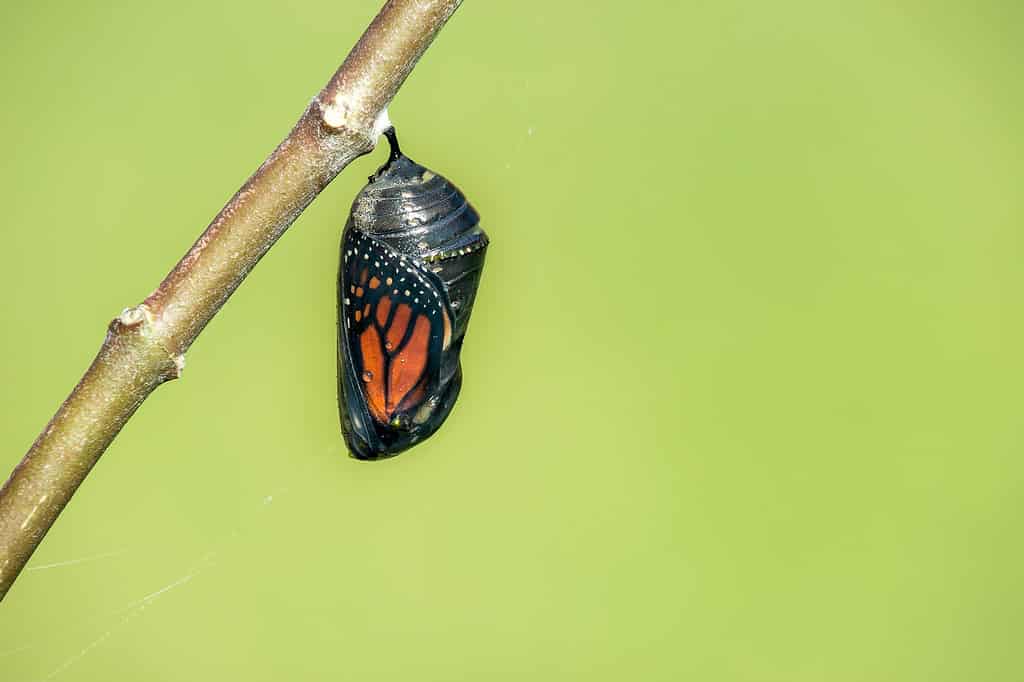
It is exciting to watch the chrysalis of a monarch butterfly as it develops and emerges.
©Leena Robinson/Shutterstock.com
In the Americas, the monarchs leave their overwintering sites in the Sierra Madre mountains of Michoacan and Mexico to travel to Texas and Oklahoma to lay eggs on milkweed before the end of their lifespan. These eggs hatch and undergo their complete metamorphosis before traveling hundreds of miles across the U. S. and Canada. A fourth generation develops in the northernmost part of the monarchs range – the great-grandchildren of the butterflies that overwintered in Mexico. That group begins life in Maine before retracing the entire journey back to Mexico – stopping to lay eggs on milkweed along the way.
The distribution of native milkweed species has been drastically affected by the use of pesticides and herbicides, habitat loss due to agriculture, logging, and urbanization, and by fires, storms, droughts, and invasive species associated with climate change. You can do your part to revive the plant and the butterfly by planting milkweed in a sunny spot on your property. It can easily form the backdrop of a sunny garden and will attract a variety of pollinators in addition to the monarch butterflies. Perhaps the milkweed bushes you plant will enable your children or grandchildren to experience the wonder of the monarch butterfly’s metamorphosis – sparking dreams of beauty, transformation and heaven.
The photo featured at the top of this post is © IanRedding/Shutterstock.com
Thank you for reading! Have some feedback for us? Contact the AZ Animals editorial team.



